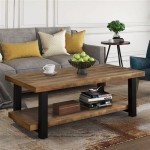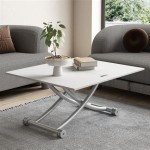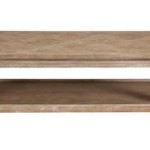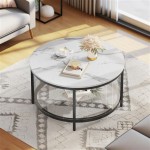What Is Trending in Coffee Tables
The coffee table, a central piece in living rooms and sitting areas, serves both functional and aesthetic purposes. As interior design trends evolve, so do the styles, materials, and features of these essential furnishings. Understanding current trends in coffee tables helps consumers make informed decisions that align with contemporary design sensibilities and practical needs.
Natural Materials and Textures
A significant trend in coffee table design is the use of natural materials and textures. This reflects a broader movement towards biophilic design, which seeks to connect indoor spaces with the natural world. Materials such as solid wood, stone, and rattan are increasingly popular choices, offering a sense of warmth, authenticity, and organic beauty.
Solid wood coffee tables are particularly desirable for their durability and inherent character. Different wood species, such as oak, walnut, and reclaimed timber, provide varying grains, colors, and textures. Oak, known for its strength and light color, is often used in Scandinavian-inspired designs. Walnut, with its rich, dark tones, complements mid-century modern and contemporary aesthetics. Reclaimed timber, sourced from old buildings or furniture, adds a rustic and eco-friendly touch.
Stone coffee tables, crafted from materials like marble, granite, or travertine, offer a luxurious and sophisticated look. Marble, with its unique veining and polished surface, is a classic choice for elegant living rooms. Granite, known for its durability and resistance to stains, is suitable for high-traffic areas. Travertine, with its earthy tones and textured surface, adds a natural and rustic element.
Rattan and wicker coffee tables are gaining traction as consumers seek to incorporate natural textures into their homes. These materials, derived from plants, offer a lightweight and airy feel, making them ideal for bohemian and coastal-inspired interiors. Rattan coffee tables often feature intricate weaves and patterns, adding visual interest and tactile appeal.
The incorporation of natural materials extends beyond the primary construction of the coffee table. Many designs now incorporate natural elements as decorative accents, such as live-edge wood slabs, stone inlays, or woven water hyacinth details. These subtle touches enhance the organic aesthetic and contribute to a calming and inviting atmosphere.
Geometric Shapes and Architectural Forms
Geometric shapes and architectural forms are another prominent trend in coffee table design. This trend emphasizes clean lines, sharp angles, and sculptural silhouettes, creating visually striking focal points in living spaces. Coffee tables featuring geometric designs often exhibit a sense of modernity and sophistication.
Square and rectangular coffee tables with minimalist designs remain popular, particularly in contemporary interiors. However, designers are increasingly experimenting with unconventional shapes, such as hexagons, octagons, and triangles. These geometric forms add visual interest and create a sense of dynamism in the room.
Round coffee tables are also experiencing a resurgence in popularity, offering a softer and more organic alternative to angular designs. Round coffee tables promote a sense of flow and conversation, making them suitable for social spaces. They can be particularly effective in smaller living rooms, as their curved edges help to soften the overall appearance of the space.
Architectural forms are evident in coffee tables that mimic structural elements found in buildings and bridges. These designs often feature cantilevered surfaces, interlocking planes, and exposed metal frames, creating a sense of visual complexity and engineering prowess. Coffee tables with architectural features are often considered statement pieces, capable of transforming the entire aesthetic of a room.
The use of metal accents is common in geometric and architectural coffee table designs. Metal frames, legs, and decorative elements add a touch of industrial chic and provide structural support. Popular metal finishes include brushed brass, polished chrome, and matte black, each offering a distinct aesthetic appeal.
Functionality and Versatility
Functionality and versatility are increasingly important considerations in coffee table design. Consumers are seeking coffee tables that not only look stylish but also provide practical storage solutions and adaptability to different needs. This trend reflects a desire for multi-functional furniture that maximizes space and enhances daily living.
Coffee tables with built-in storage compartments are highly sought after. These storage solutions can take various forms, such as drawers, shelves, or lift-top mechanisms. Drawers are ideal for storing small items like remote controls, magazines, and coasters. Shelves provide open storage for books, decorative objects, or blankets. Lift-top coffee tables offer hidden storage for larger items and can be raised to create a temporary workspace or dining surface.
Nesting coffee tables are another popular choice for their versatility and space-saving design. These tables consist of two or more smaller tables that can be nested together when not in use or separated to provide additional surface area when needed. Nesting coffee tables are particularly useful in smaller living rooms, where space is limited.
Convertible coffee tables are designed to transform into different configurations to suit various activities. Some models can be extended in length or height, while others can be folded up for easy storage. Convertible coffee tables are ideal for apartments and multi-purpose spaces, where furniture needs to adapt to changing needs.
Coffee tables with casters or wheels offer mobility and flexibility. These tables can be easily moved around the room to accommodate different seating arrangements or activities. Coffee tables with casters are particularly useful in open-plan living spaces, where furniture needs to be reconfigured frequently.
The integration of technology is also becoming more common in coffee table design. Some models feature built-in charging ports, wireless charging pads, or even integrated speakers. These features cater to the modern lifestyle and provide added convenience for users.
The materials used in functional coffee tables are often chosen for their durability and ease of maintenance. Engineered wood, such as MDF or particleboard, is a popular choice for its affordability and resistance to warping. Laminate surfaces provide a durable and easy-to-clean finish, making them suitable for high-traffic areas.
In summary, the current trends in coffee tables reflect a growing emphasis on natural materials, geometric shapes, and functional design. Consumers are seeking coffee tables that not only enhance the aesthetic appeal of their living spaces but also provide practical storage solutions and adaptability to different needs. By understanding these trends, consumers can make informed decisions that align with their personal style and lifestyle preferences.

Trends For 2024 S Coffee Tables Fabuliv Blogs

Modern Marble Coffee Tables For Your Living Room Makeover Inspired Design Talk

Top Trendy Coffee Table Designs From Cherrypick Showroom

16 Best Coffee Tables To In 2024 Today
:max_bytes(150000):strip_icc()/152945062_737282207181204_134449455905291253_n-a72421cb62fc4ea9a60c78f9974447cd-fb1f12467d434f12aec171da38b01d42.jpg?strip=all)
45 Coffee Table Decor Ideas

House And Haven The Perfect Coffee Table Collection In 2024 Trending Living Room Pieces
2024 Living Room Trends What S Out And Will Be Popular

The Diffe Kinds Of Coffee Tables Modern Re

Coffee Tables

Fashionable Coffee Tables Minimalist Living Room Decor Glam







